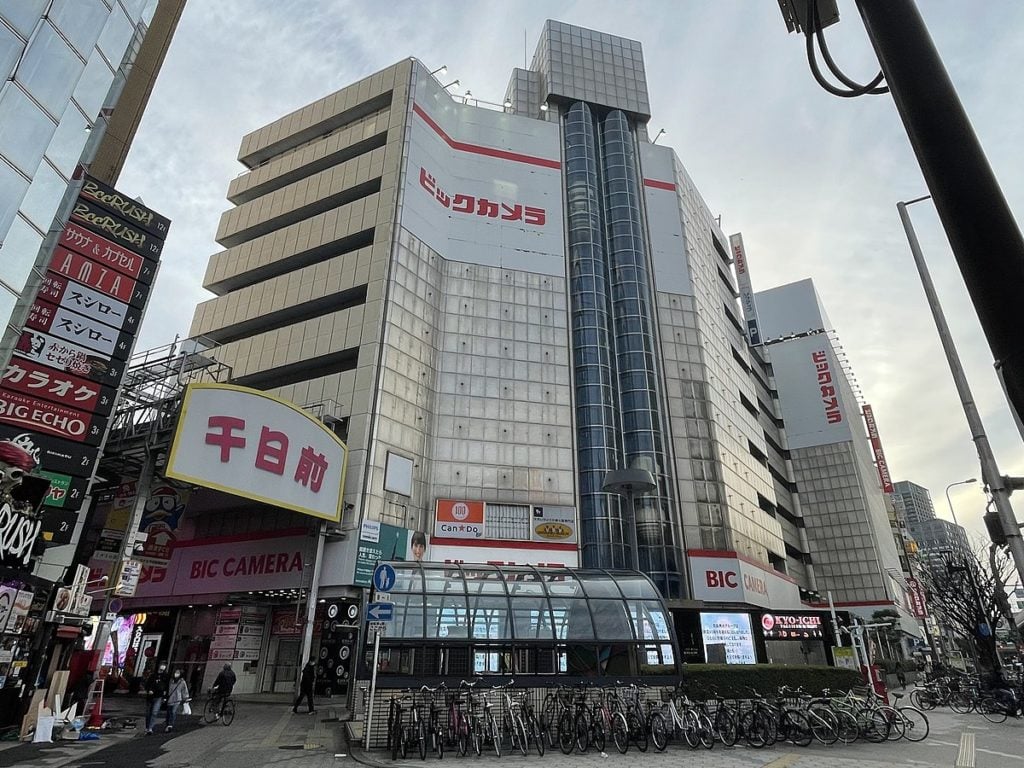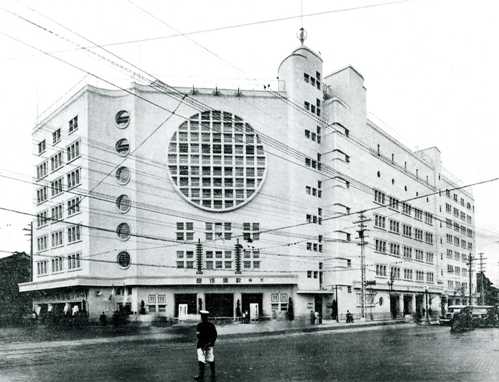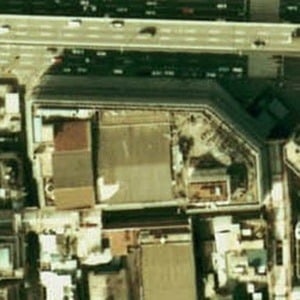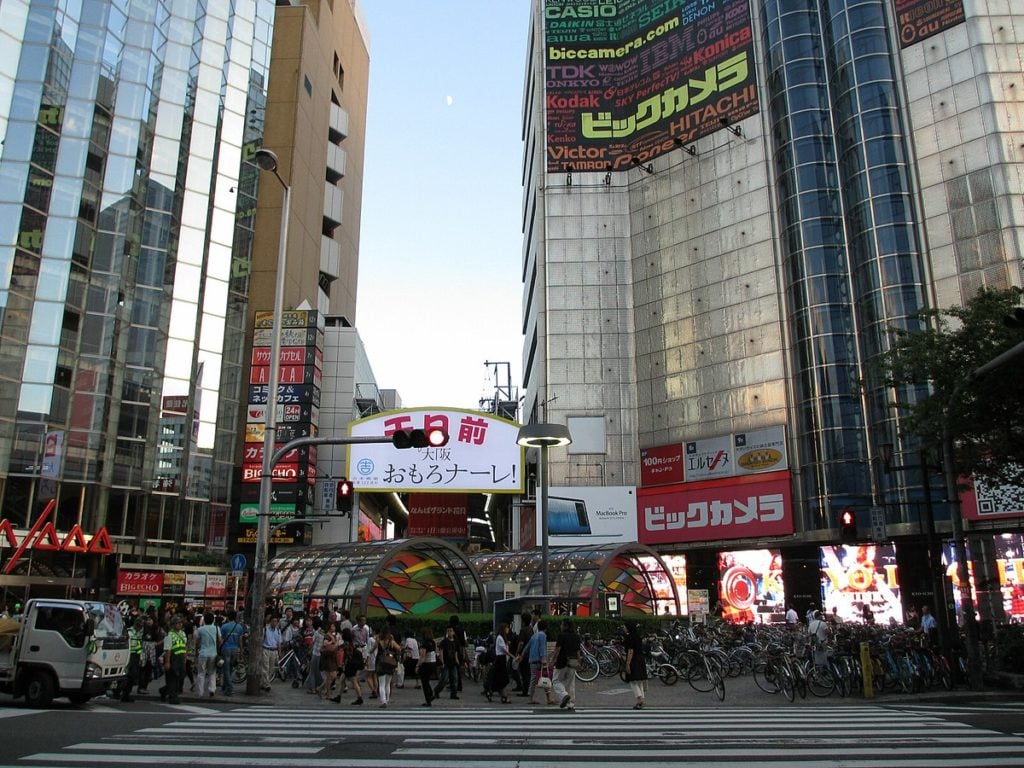Previously: Knock-Knock Road, Michigan.
(CW: Massive building fire with an incredibly high loss of life in incredibly horrifying ways.)
The Bic Camera location in Namba is far from the only Bic Camera location in Osaka. Bic Camera, after all, has about 42 stores spread across Japan, as of February 2020; it’s one of the largest electronics and home appliance retailers in the entire country. Four of these stores are in Osaka — but the one in Namba is special. The one in Namba has a history. The Bic Camera in Namba, Osaka, might actually be haunted.
[Like what you read? Check out Dangerous Games To Play In The Dark, available from Chronicle Books now!]
The building that currently houses Bic Camera’s Namba store hasn’t always been there, you see. It was built in the 1980s, and first played host to a global branch of a French department store. But that building is quite literally built on the ashes of yet another department store — a uniquely Japanese one: Between the late 1950s and early 1970s, the ground on which Bic Camera now stands was occupied by the Sennichi Department Store.

Yes, that Sennichi Department Store.
The Sennichi Department Store which, the night before Mother’s Day in 1972, burned to the ground, killing more than 100 people. To this day, the Sennichi Department Store fire remains Japan’s deadliest building fire.
It’s no wonder the place has a… reputation.
On Sept. 28, 1932, the Osaka Kabukiza (大阪歌舞伎座) — Osaka’s first modern kabuki theatre — opened in Namba. Large and modern for the time, the theatre had a seating capacity of a whopping 3,000 — but although it did well in its early years, things changed after the conclusion of the Second World War. During this period, kabuki fell out of popular favor, and with few ticket sales to support such a huge facility, the original Osaka Kabukiza closed in 1958 and moved to a smaller location nearby, the Shin-Kabukiza. After the kabuki theatre left, the building was renovated and turned into something new: The Sennichi Department Store.

The store actually wasn’t originally meant to be a department store. The plan during its construction was for it to be something similar to what we now think of as a shopping mall, full of individual stores and counters rented out to independent merchants, rather than one large store with different departments. If the store had opened up under its original model, it would have been the first shopping center of this variety opened in Japan. (The Plaza House Center in Okinawa technically beat Sennichi to this title; it opened in 1954. However, as the Plaza House Center was a product of the United States’ occupation of Okinawa, it’s not typically considered the first Japanese shopping mall — and, indeed, even now, it’s usually referred to as an American-style mall.) However, due to a lack of applications from tenants, the model was changed to that of a standard department store prior to opening — and when the shopping facility did finally open its doors in 1958, it was under the name Sennichi Department Store.
By the 1970s, the Sennichi Department Store was — like many department stores aimed to be at the time — much more than just a place to do your shopping. The basement played host to a food hall, a restaurant, a coffee shop, and a special event space that was, at the time, occupied by a haunted house attraction; the first and second floors held a total of 126 specialty stores; the Nichii Sennichimae clothing store took up the third and fourth floors; a supermarket and a beauty salon were available on the fifth floor; an arcade, also known as a game center, occupied the sixth floor, along with the remains of a theatre space that was slated to be turned into a bowling alley; a cabaret nightclub called Playtown called the seventh floor home; and on the rooftop, there was, among other things, an amusement park, including a Ferris wheel that had opened up in 1960.
Business hours for most of the building ran from 10am to 9pm — except for Playtown. The club was typically open until 11pm. It was one of Osaka’s most popular nightlife spots, and on Saturday nights, it wasn’t out of the ordinary for the place to be filled to capacity.
Such was the case the evening of Saturday, May 13, 1972.
But this time, the evening would end in disaster.

At around 10:27pm, a flame sparked on the third floor near the bedding and kimono department. It’s still not entirely clear what caused that spark; it’s thought to have been a smoldering cigarette inadequately extinguished by a construction worker, but it could also have been the result of faulty wiring. Extensive electrical work was scheduled to be carried out on the third floor in just a little over a week — hence both the presence of construction workers, who were preparing the area for the upcoming work, and the possibility of a flaw in the electric system triggering the fire.
Whatever the cause, the effect was immediate: A column of flame and a wave of thick, black smoke. Efforts to extinguish the flame failed; it was simply too strong, burning too brightly. By 10:40pm, it had leaped to the fourth floor through the opening of an escalator whose fire cover shutter had been left open — and from there, it continued to spread, greedily drinking up every ounce of oxygen available.
At around this time, the party-goers at Playtown began to detect the presence of smoke — and soon realized that the building was ablaze. The elevators became inoperable, but due to fatal flaws in the design of the building and issues with the construction occurring within it, neither were other egresses easily accessible. The building had no sprinklers; the fire shutters were inoperable; and the fire exits were locked. By the time the first fire brigade arrived at 10:43, the inside of the club had turned into the scene of a mass panic, which was greatly exacerbated when the lights blew out at 10:49.
That was when the people trapped inside started to jump.
Rescue operations initially proceeded alongside efforts to extinguish the blaze. Some did manage to escape — but at 11:30pm, it was determined that there were no more survivors left alive in the burning building. The firefighters on the scene switched out of rescue mode and focused solely on putting the massive fire out. They fought through the night, reaching suppression at 5:43 in the morning on Sunday, May 14 and extinguishment finally occurring at 5:30pm on Monday, May 14.
The Sennichi Department Store fire ultimately claimed 118 lives — most from carbon monoxide poisoning, but some who fell to their deaths, and three from injuries sustained during the mass panic. All of them had been at Playtown when the fire began. The death toll, combined with the 78 additional people injured during the night, has cemented this fire as the worst building fire in post-war Japanese history.
The ruins of the former department store remained in place for a full decade before finally being demolished in 1982. The site wouldn’t stay vacant for long, though; just two years later, on Jan. 14, 1984, a new shop opened in a newly-constructed building where the Sennichi Department Store had once stood: A branch of the French department store Printemps, which, on the verge of celebrating its 120th birthday, had begun to expand globally in the years prior. And here, history begins to repeat itself just a little: Like the Osaka Kabukiza had been before it, the Printemps building underwent renovations not quite two decades later, and in 2001, reopened with yet another new tenant within. On May 1 of that year, the Namba location of Bic Camera began welcoming customers — and it’s been there ever since.

But although the actual building housing Bic Camera Namba isn’t the same one that the Sennichi Department Store once called home, some say that the location itself still bears the scars of its deadly past.
Some say, for example, that sometimes, when you’re traveling on the Sennichimae Subway Line running beneath the building, you’ll hear cries for help floating out of the walls. Some say that taxi drivers picking up women dressed in kimono in front of the building will sometimes find their passengers to have vanished by the time they arrive at their destination.
And within the building itself? There’s plenty of alleged activity there, as well. Some say that longtime employees won’t go to work unless they’re wearing prayer beads or carrying a protective charm. Some say that occasionally, a disembodied voice near the gift-wrap station can be heard repeating one word, over and over again: “Fire. Fire. Fire.” Some say that if you smoke in the employee smoking lounge in the basement level, you’ll feel a constant pressure pushing down on your shoulders — a plea not to smoke, maybe, from those who died in a fire begun by an improperly extinguished cigarette. Some say that, at night, you might hear loud, thumping noises nearby — the sound, perhaps, of those who fell to their deaths attempting to escape the blaze. Some say that women in kimono sometimes appear in the restroom, only to disappear into the wall.
There’s even an allegedly cursed photograph associated with the Sennichi Department Store fire. The photograph depicts a row of charred, heavily damaged mannequins wearing kimono — and if you look at it — if you so much as glance at it — you’ll begin having terrible nightmares. The mannequins will appear to you, night after night, speaking a number to you with each new descent into the horrors of sleep. The numbers are not the same each night; they seem to be… counting down to something.
Your death, perhaps.
What else could it mean?
Of course, as is often the case with image-based urban legends, it’s difficult to tell whether this photograph actually depicts the aftermath of the Sennichi Department Store fire or not. This image has been knocking around the internet in Japan for some time — at least since 2012, according to this thread from 2ch’s occult board — but it’s not always presented the same way. Sometimes, it’s identified as the Sennichi image; sometimes it has no context whatsoever; and sometimes, it’s actually identified as a photo of a different department store fire that occurred a year and a half after the Sennichi fire — and much further away: The Taiyo Department Store fire, which occurred in Kumamoto City on the southern Japanese island of Kyushu on Nov. 29, 1973.
Photos do exist of both the Sennichi and Taiyo fires, but I haven’t seen the mannequin photo included in the photo sets of either disaster at any editorial photo archive databases. Still, though, I have found some scant evidence that suggests the mannequin photo is, in fact, from the Taiyo Department Store fire. So, the “cursed photo” part of the Sennichi legend, at least, seems to be just that — a legend.
That doesn’t stop the image from being any less horrifying, though. And, it’s worth noting, the Taiyo Department Store fire was almost as deadly as the Sennichi Department Store fire. In fact, it was these two fires which led to the amendment of the Construction Standard Law and the Fire Fighting Law in Japan — but at an all-too-steep human cost.
There are some, by the way, who believe the haunting goes back even further than the Sennichi Department Store. There’s little evidence in the historical record of this part of the tale — but according to legend, the plot of land in Namba that has, over the years, held a kabuki theatre, a deadly department store, a purveyor of European goods, and an electronics superstore… is also the site of a mass grave.
From 1614 to 1615, Osaka lay under siege as war waged between the Tokugawa shogunate and the Toyotomi clan. The Battle of Tennōji brought the conflict to an end — but at great cost: A total of 23,000 to 26,600 were killed, with losses suffered on both sides. It’s said that the Tokugawa shogunate declared the bodies of the dead to buried at mass grave sites throughout Osaka — one of which is said to have been right beneath where the Sennichi Department Store would later open its doors.
It probably doesn’t help matters that this spot is also believed to have been an execution ground used during the duration of the Tokugawa shogunate, too.
In other words, it’s possible that the very ground itself is cursed.
Or not. Again, this part of the tale isn’t well supported by the historical record; the siege happened, as did the battle, but whether the mass grave exists remains to be seen. And, furthermore, although some say that the area is haunted to this very day, others say that the activity died off after the ‘90s.
Still, though.
The fire did happen.
And it was extraordinarily deadly.
But you’d never know it just by stepping into the Bic Camera Namba store today — unless, of course, you were already familiar with the history.
So, if you’re in the area and interested in more than just doing a little shopping? Stop on by.
(Don’t forget your mask.)
It’s just a five- or 10-minute walk from the three nearest public transit stops — Osaka-Namba Station on the Kintetsu Namba and Hanshin Namba Lines of the Kintetsu Railway and Hanshin Electric Railway; Namba Station on the Nankai Main Line and Nankai Koya Line of the Nankia Electric Railway and the Osaka Metro Midōsuji, Sennichimae, and Yotsubashi Lines; and JR Namba.
At the very least, you’ll walk away from the experience having paid your respects, right?
***
Follow The Ghost In My Machine on Twitter @GhostMachine13 and on Facebook @TheGhostInMyMachine. And don’t forget to check out Dangerous Games To Play In The Dark, available now from Chronicle Books!
[Photos via Tokumeigakarinoaoshima, public domain, Ministry of Land, Infrastructure, Transport and Tourism of Japan, DVMG/Wikimedia Commons, available under CC BY-SA 4.0 and CC BY 3.0 Creative Common licenses and the public domain; Mulboyn/Twitter.]